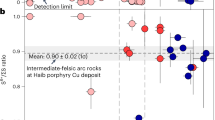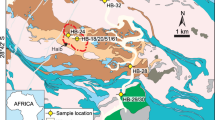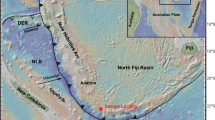Abstract
Despite the economic importance of chalcophile (sulfide-loving) and siderophile (metal-loving) elements (CSEs), it is unclear how they become enriched or depleted in the continental crust, compared with the oceanic crust. This is due in part to our limited understanding of the partitioning behaviour of the CSEs. Here I compile compositional data for mid-ocean ridge basalts and subduction-related volcanic rocks. I show that the mantle-derived melts that contribute to oceanic and continental crust formation rarely avoid sulfide saturation during cooling in the crust and, on average, subduction-zone magmas fractionate sulfide at the base of the continental crust prior to ascent. Differentiation of mantle-derived melts enriches lower crustal sulfide- and silicate-bearing cumulates in some CSEs compared with the upper crust. This storage predisposes the cumulate-hosted compatible CSEs (such as Cu and Au) to be recycled back into the mantle during subduction and delamination, resulting in their low contents in the bulk continental crust and potentially contributing to the scarcity of ore deposits in the upper continental crust. By contrast, differentiation causes the upper oceanic and continental crust to become enriched in incompatible CSEs (such as W) compared with the lower oceanic and continental crust. Consequently, incompatible CSEs are predisposed to become enriched in subduction-zone magmas that contribute to continental crust formation and are less susceptible to removal from the continental crust via delamination compared with the compatible CSEs.
This is a preview of subscription content, access via your institution
Access options
Access Nature and 54 other Nature Portfolio journals
Get Nature+, our best-value online-access subscription
$29.99 / 30 days
cancel any time
Subscribe to this journal
Receive 12 print issues and online access
$259.00 per year
only $21.58 per issue
Buy this article
- Purchase on Springer Link
- Instant access to full article PDF
Prices may be subject to local taxes which are calculated during checkout





Similar content being viewed by others
References
Palme, H. & O’Neill, H. St. C. in Treatise on Geochemistry: The Mantle and Core (ed. Carlson, R. W.) 1–39 (Elsevier–Pergamon, 2014).
Lee, C.-T. A. et al. Copper systematics in arc magmas and implications for crust-mantle differentiation. Science 336, 64–68 (2012).
Lee, C.-T. A., Leeman, W. P., Canil, D. & Li, Z.-X.A. Similar V/Sc systematics in MORB and arc basalts: implications for the oxygen fugacities of their mantle source regions. J. Petrol. 46, 2313–2336 (2005).
Nielsen, S. G. et al. Tracking along-arc sediment inputs to the Aleutian arc using thallium isotopes. Geochim. Cosmochim. Acta 181, 217–237 (2016).
Wilkinson, J. J. Triggers for the formation of porphyry ore deposits in magmatic arcs. Nat. Geosci. 6, 917–925 (2013).
Timm, C., de Ronde, C. E. J., Leybourne, M. I., Layton-Matthews, D. & Graham, I. J. Sources of chalcophile and siderophile elements in kermadec arc lavas. Econ. Geol. 107, 1527–1538 (2012).
Jenner, F. E., O’Neill, H. St. C., Arculus, R. J. & Mavrogenes, J. A. The magnetite crisis in the evolution of arc-related magmas and the initial concentration of Au, Ag, and Cu. J. Petrol. 51, 2445–2464 (2010).
Jenner, F. E. et al. The competing effects of sulfide saturation versus degassing on the behavior of the chalcophile elements during the differentiation of hydrous melts. Geochem. Geophys. Geosyst. 16, 1490–1507 (2015).
Salters, V. J. M. & Stracke, A. Composition of the depleted mantle. Geochem. Geophys. Geosyst. 5, Q05004 (2004).
Richards, J. P. The oxidation state, and sulfur and Cu contents of arc magmas: implications for metallogeny. Lithos 233, 27–45 (2015).
Gale, A., Dalton, C. A., Langmuir, C. H., Su, Y. & Schilling, J.-G. The mean composition of ocean ridge basalts. Geochem. Geophys. Geosyst. 14, 489–518 (2013).
Arevalo, R. & McDonough, W. F. Chemical variations and regional diversity observed in MORB. Chem. Geol. 271, 70–85 (2010).
Jenner, F. E. & Arevalo, R. D. Major and trace element analysis of natural and experimental igneous systems using LA–ICP–MS. Elements 12, 311–316 (2016).
Yi, W. et al. Cadmium, indium, tin, tellurium, and sulfur in oceanic basalts: implications for chalcophile element fractionation in the Earth. J. Geophys. Res. 105, 18927–18948 (2000).
Jochum, K. P. & Hofmann, A. W. Constraints on Earth evolution from antimony in mantle-derived rocks. Chem. Geol. 139, 39–49 (1997).
Noll, J. P. D., Newsom, H. E., Leeman, W. P. & Ryan, J. G. The role of hydrothermal fluids in the production of subduction zone magmas: evidence from siderophile and chalcophile trace elements and boron. Geochim. Cosmochim. Acta 60, 587–611 (1996).
Chiaradia, M. Copper enrichment in arc magmas controlled by overriding plate thickness. Nat. Geosci. 7, 43–46 (2014).
Sun, W. et al. Porphyry deposits and oxidized magmas. Ore Geol. Rev. 65, Part 1, 97–131 (2015).
Witt-Eickschen, G., Palme, H., O’Neill, H. St. C. & Allen, C. M. The geochemistry of the volatile trace elements As, Cd, Ga, In and Sn in the Earth’s mantle: new evidence from in situ analyses of mantle xenoliths. Geochim. Cosmochim. Acta 73, 1755–1778 (2009).
Tanner, D., Mavrogenes, J. A., Arculus, R. J. & Jenner, F. E. Trace element stratigraphy of the Bellevue Core, Northern Bushveld: multiple magma injections obscured by diffusive processes. J. Petrol. 55, 859–882 (2014).
Jenner, F. E. & O’Neill, H. St. C. Analysis of 60 elements in 616 ocean floor basaltic glasses. Geochem. Geophys. Geosyst. 13, Q02005 (2012).
Patten, C., Barnes, S.-J., Mathez, E. A. & Jenner, F. E. Partition coefficients of chalcophile elements between sulfide and silicate melts and the early crystallization history of sulfide liquid: LA-ICP-MS analysis of MORB sulfide droplets. Chem. Geol. 358, 170–188 (2013).
Kiseeva, E. S. & Wood, B. J. The effects of composition and temperature on chalcophile and lithophile element partitioning into magmatic sulphides. Earth Planet. Sci. Lett. 424, 280–294 (2015).
Li, Y. & Audétat, A. Partitioning of V, Mn, Co, Ni, Cu, Zn, As, Mo, Ag, Sn, Sb, W, Au, Pb, and Bi between sulfide phases and hydrous basanite melt at upper mantle conditions. Earth Planet. Sci. Lett. 355–356, 327–340 (2012).
Jenner, F. E. et al. Chalcophile element systematics in volcanic glasses from the northwestern Lau Basin. Geochem. Geophys. Geosyst. 13, Q06014 (2012).
Rudnick, R. L. & Gao, S. in Treatise on Geochemistry: The Crust (ed. Rudnick, R. L.) 1–64 (Elsevier, 2003).
Dare, S. S., Barnes, S.-J. & Prichard, H. The distribution of platinum group elements (PGE) and other chalcophile elements among sulfides from the Creighton Ni–Cu–PGE sulfide deposit, Sudbury, Canada, and the origin of palladium in pentlandite. Miner. Deposita 45, 765–793 (2010).
Freymuth, H., Vils, F., Willbold, M., Taylor, R. N. & Elliott, T. Molybdenum mobility and isotopic fractionation during subduction at the Mariana arc. Earth Planet. Sci. Lett. 432, 176–186 (2015).
Freymuth, H., Ivko, B., Gill, J. B., Tamura, Y. & Elliott, T. Thorium isotope evidence for melting of the mafic oceanic crust beneath the Izu arc. Geochim. Cosmochim. Acta 186, 49–70 (2016).
Elliott, T., Plank, T., Zindler, A., White, W. & Bourdon, B. Element transport from slab to volcanic front at the Mariana arc. J. Geophys. Res. 102, 14991–15019 (1997).
Prytulak, J., Nielsen, S. G., Plank, T., Barker, M. & Elliott, T. Assessing the utility of thallium and thallium isotopes for tracing subduction zone inputs to the Mariana arc. Chem. Geol. 345, 139–149 (2013).
White, W. M. & Klein, E. M. in Treatise on Geochemistry: The Crust 2nd edn (eds Turekian, K. & Holland, H.) 457–496 (Elsevier, 2014).
O’Neill, H. St. C. & Jenner, F. E. The global pattern of trace-element distributions in ocean floor basalts. Nature 491, 698–704 (2012).
O’Neill, H. St. C. & Jenner, F. E. Causes of the compositional variability among ocean floor basalts. J. Petrol. 57, 2163–2194 (2017).
Li, Y. Chalcophile element partitioning between sulfide phases and hydrous mantle melt: applications to mantle melting and the formation of ore deposits. J. Asian Earth Sci. 94, 77–93 (2014).
Zhang, Z. & Hirschmann, M. M. Experimental constraints on mantle sulfide melting up to 8 GPa. Am. Miner. 101, 181–192 (2016).
Adam, J. & Green, T. Trace element partitioning between mica- and amphibole-bearing garnet lherzolite and hydrous basanitic melt: 1. Experimental results and the investigation of controls on partitioning behaviour. Contrib. Mineral. Petrol. 152, 1–17 (2006).
Wang, Z. & Becker, H. Abundances of Ag and Cu in mantle peridotites and the implications for the behavior of chalcophile elements in the mantle. Geochim. Cosmochim. Acta 160, 209–226 (2015).
Pearce, J. A., Stern, R. C., Bloomer, S. H. & Fryer, P. Geochemical mapping of the Mariana arc-basin system: implications for the nature and distribution of subduction components. Geochem. Geophys. Geosyst. 6, Q07006 (2005).
Guillot, S. & Hattori, K. Serpentinites: essential roles in geodynamics, arc volcanism, sustainable development, and the origin of life. Elements 9, 95–98 (2013).
Peucker-Ehrenbrink, B., Hofmann, A. W. & Hart, S. R. Hydrothermal lead transfer from mantle to continental crust: the role of metalliferous sediments. Earth Planet. Sci. Lett. 125, 129–142 (1994).
Staudigel, H. Treatise on Geochemistry: The Crust 2nd edn (eds Holland, H. D. & Turekian, K. K.) 583–606 (Elsevier, 2014).
Tomkins, A. G., Pattison, D. R. M. & Frost, B. R. On the initiation of metamorphic sulfide anatexis. J. Petrol. 48, 511–535 (2007).
Matjuschkin, V., Blundy, J. D. & Brooker, R. A. The effect of pressure on sulphur speciation in mid- to deep-crustal arc magmas and implications for the formation of porphyry copper deposits. Contrib. Mineral. Petrol. 171, 1–25 (2016).
Wallace, P. J. Volatiles in subduction zone magmas: concentrations and fluxes based on melt inclusion and volcanic gas data. J. Volcanol. Geotherm. Res. 140, 217–240 (2005).
Hermann, J. Allanite: thorium and light rare element carrier in subducted crust. Chem. Geol. 192, 287–306 (2002).
Blichert-Toft, J. et al. Large-scale tectonic cycles in Europe revealed by distinct Pb isotope provinces. Geochem. Geophys. Geosyst. 17, 3854–3864 (2016).
Annen, C., Blundy, J. D. & Sparks, R. S. J. The genesis of intermediate and silicic magmas in deep crustal hot zones. J. Petrol. 47, 505–539 (2006).
Plank, T., Kelley, K. A., Zimmer, M. M., Hauri, E. H. & Wallace, P. J. Why do mafic arc magmas contain ∼4 wt% water on average? Earth Planet. Sci. Lett. 364, 168–179 (2013).
Simons, B., Andersen, J. C. Ø., Shail, R. K. & Jenner, F. E. Fractionation of Li, Be, Ga, Nb, Ta, In, Sn, Sb, W and Bi in the peraluminous Early Permian Variscan granites of the Cornubian Batholith: precursor processes to magmatic-hydrothermal mineralisation. Lithos 278–281, 491–512 (2017).
Jenner, F. E. & O’Neill, H. S. C. Major and trace analysis of basaltic glasses by laser-ablation ICP-MS. Geochem. Geophys. Geosyst. 13, Q03003 (2012).
Jenner, F. E., Holden, P., Mavrogenes, J. A., O’Neill, H. S. C. & Allen, C. Determination of selenium concentrations in NIST SRM 610, 612, 614 and geological glass reference materials using the electron probe, LA-ICP-MS and SHRIMP II. Geostand. Geoanal. Res. 33, 309–317 (2009).
Acknowledgements
H. O’Neill, J. Prytulak, R. Rudnick, H. Williams, S. Kelley, E. Hauri, J. Bryce, T. Elliott, J. Blundy, N. Rogers, N. Harris, R. Carlson and C. Hawkesworth are thanked for motivational comments that helped improve my ability to deliver an accessible manuscript. I would like to thank the NERC (grant reference NE/M000427/1 and NE/M010848/1) for funding. B. Wood, Y. Li, A. Hoffmann and F. Albaréde are thanked for constructive reviews and comments.
Author information
Authors and Affiliations
Corresponding author
Ethics declarations
Competing interests
The author declares no competing financial interests.
Supplementary information
Supplementary Information
Supplementary Information (PDF 315 kb)
Supplementary Information
Supplementary Information (XLSX 159 kb)
Rights and permissions
About this article
Cite this article
Jenner, F. Cumulate causes for the low contents of sulfide-loving elements in the continental crust. Nature Geosci 10, 524–529 (2017). https://doi.org/10.1038/ngeo2965
Received:
Accepted:
Published:
Issue Date:
DOI: https://doi.org/10.1038/ngeo2965
This article is cited by
-
Underplated melts control sulfide segregation at the continental crust-mantle transition
Communications Earth & Environment (2024)
-
Sulfide saturation and resorption modulates sulfur and metal availability during the 2014–15 Holuhraun eruption, Iceland
Communications Earth & Environment (2024)
-
Sulfide minerals and chalcophile elements in The Pleiades Volcanic Field, Antarctica: implications for the distribution of chalcophile metals in continental intraplate alkaline magma systems
Contributions to Mineralogy and Petrology (2023)
-
Mobilisation of deep crustal sulfide melts as a first order control on upper lithospheric metallogeny
Nature Communications (2022)
-
Sulfur and chlorine budgets control the ore fertility of arc magmas
Nature Communications (2022)



